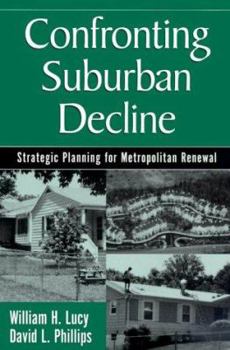Confronting Suburban Decline: Strategic Planning for Metropolitan Renewal
Sprawling commercial and residential development in outer suburbs and exurban areas has for a number of years masked increasingly severe socioeconomic problems in suburban America. In recent decades,... This description may be from another edition of this product.
Format:Paperback
Language:English
ISBN:1559637706
ISBN13:9781559637701
Release Date:March 2000
Publisher:Island Press
Length:384 Pages
Weight:1.10 lbs.
Dimensions:0.7" x 6.0" x 9.0"
Customer Reviews
2 ratings
Excellent overview of neglected problem
Published by Thriftbooks.com User , 19 years ago
This book has tons of statistics gathered in one place on the impacts of sprawl on older communities, and how shifts in development (including mushrooming house sizes) have put older suburbs and their smaller homes at a disadvantage. This is the best book on outlining the problems faced by older suburbs and why decline is happening. Perhaps the most intriguing finding is that communities with older homes don't necessarily decline, but that homes built between 1940 and 1970 are most vulnerable. Home renovation expenditures are not keeping pace with the rate at which homes depreciate and need major systems replacements. Urbanists should be paying more attention to these neighborhoods, which are often neither the stereotypical exclusionary privileged suburbs, nor are they usually filled with the poorest of the poor (though they may have concentrations of poverty). They face perhaps a more challenging road to recovery than more urban neighborhoods closer to various city amenities-- unless their decline can be addressed sooner rather than later. Current public policies are not structured to tackle these communities, and jurisdictions may be in denial or challenged by a limited tax base and sentiment against raising taxes.
great work
Published by Thriftbooks.com User , 22 years ago
Some think of sprawl as a simple zero sum game: suburbs win, cities lose. But this book explains (with quantitative analysis from numerous regions) that sprawl, like the French Revolution, devours its own children: that older suburbs decline as newer suburbs suck away their elites. That fact is of course common knowledge in the Rust Belt. But Lucy and Phillips add another level of detail, explaining how some places have survived the rising tide of sprawl while others go into meltdown. Suburbs (and city neighborhoods) with historic housing and pedestrian-friendly features have often managed to keep up with the rest of their metro areas, while typical 1950s suburbs are the biggest losers from sprawl because they are stuck with the worst of both worlds: their housing is too small for 21st century tastes, yet they lack the urban amenities that lead to gentrification.





